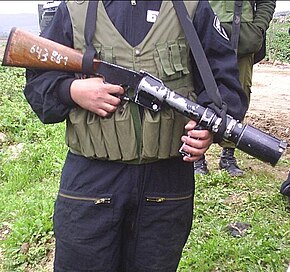
Federal Laboratories (often FedLabs or Federal Labs) was a company that manufactured tear gas and less-lethal riot guns, including the popular Federal Riot Gun, based in Pittsburgh and established in the early part of the 20th century.
History of use
Civil order in the United States

In the 1930s, custom gas guns by FedLabs were adopted by the New York Prison department, following a sales pitch made before the APA by the president of FedLabs in Baltimore in 1931.
Also in the 1930s, Federal Laboratories actively worked to sell gas guns for the purpose of strikebreaking. One FedLabs representative fired a tear gas grenade during the 1934 West Coast waterfront strike that caused the death of a striker due to skull fracture. Auerbach notes, however, that despite FedLabs stated opposition to "communist" strikers, the firm continued to sell tear gas to the Soviet Union even during 1933.
World War II
During World War II, the company's factory near Saltsburg, PA along Tunnelton Road employed women to replace drafted male workers. There the women produced "incendiary magnesium powder bombs, grenades and other munitions", including FedLabs tear gas grenades.
Northern Ireland
The single shot FRG became the standard riot gun used extensively by the British Army throughout The Troubles in Northern Ireland.
Israel
FedLabs gas guns, and CS and CN grenades, were imported by Israel for use in the Palestinian Territories; in 1988 FedLabs discontinued sales of CS and CN to Israel following multiple reports of abusive use of the products.
2011 Bahraini protests
Main articles: Bahraini uprising of 2011, Saudi-led intervention in Bahrain, and Arab SpringInspired by the regional Arab Spring, Bahrain's Shia majority started large protests against its Sunni rulers in early 2011. The government initially allowed protests following a pre-dawn raid on protesters camped in Pearl Roundabout. A month later it requested security assistance from Saudi Arabia and other Gulf Cooperation Council countries and declared a three-month state of emergency. The government then launched a crackdown on the opposition that included conducting thousands of arrests and systematic torture. Almost daily clashes between protesters and security forces led to dozens of deaths. Protests, sometimes staged by opposition parties, were ongoing. More than 80 civilians and 13 policemen have been killed as of March 2014. According to Physicians for Human Rights, 34 of these deaths were related to government usage of tear gas originally manufactured by U.S.-based Federal Laboratories.
Sale and fate
In March 1994, TransTechnology sold FedLabs to Mace Security International, which subsequently sold the company in 1998 to Armor Holdings. Armor holdings was in turn acquired by BAE Systems in 2007.
References
- Rebecca M. McLennan (3 March 2008). The Crisis of Imprisonment: Protest, Politics, and the Making of the American Penal State, 1776–1941. Cambridge University Press. pp. 467–. ISBN 978-1-139-46748-3.
- Jerold S. Auerbach (1966). Labor and Liberty. Ardent Media. pp. 101–. GGKEY:68ND3STN8GK.
- "Welcome".
- Ilan Peleg (1995). Human Rights in the West Bank and Gaza: Legacy and Politics. Syracuse University Press. pp. 111–. ISBN 978-0-8156-2682-4.
- "Bahrain declares state of emergency after unrest". Reuters. 15 March 2011. Archived from the original on 23 October 2012. Retrieved 3 October 2012.
- "BICI | Bahrain Independent Commission of Inquiry". www.bici.org.bh. 23 November 2011. pp. 162–163. Retrieved 22 November 2020.
- "BICI | Bahrain Independent Commission of Inquiry". www.bici.org.bh. 23 November 2011. pp. 73–74, 88. Retrieved 22 November 2020.
- "Report of the Bahrain Independent Commission of Inquiry". BICI. 23 November 2011. pp. 132–139.
- Law, Bill (6 April 2011). "Police Brutality Turns Bahrain Into 'Island of Fear'". Crossing Continents (via BBC News). Retrieved 15 April 2011.
- Press release (30 March 2011). "USA Emphatic Support to Saudi Arabia". Zayd Alisa (via Scoop). Retrieved 15 April 2011.
- Cockburn, Patrick (18 March 2011). "The Footage That Reveals the Brutal Truth About Bahrain's Crackdown – Seven Protest Leaders Arrested as Video Clip Highlights Regime's Ruthless Grip on Power". The Independent. Retrieved 15 April 2011.
- Carlstrom, Gregg (23 April 2012). "Bahrain court delays ruling in activists case". Al Jazeera English. Retrieved 14 June 2012.
- Solomon, Erika (11 June 2011). "Thousands rally for reform in Bahrain". Reuters. Archived from the original on 22 October 2012.
- "Bahrain protesters join anti-government march in Manama". BBC News. 9 March 2012. Archived from the original on 25 April 2012. Retrieved 3 October 2012.
- "Mass pro-democracy protest rocks Bahrain". Reuters. 9 March 2012. Archived from the original on 23 October 2012.
- "Bomb blast kills three Bahrain policemen". BBC. 3 March 2014. Retrieved 6 March 2014.
- "Tear Gas or Lethal Gas? Bahrain's Death Toll Mounts to 34". Physicians for Human Rights. 6 March 2012. Retrieved 12 January 2018.
- Bahrain Watch (31 July 2013). "UK's relations with Saudi Arabia and Bahrain (further written evidence)". Foreign Affairs Select Committee. Retrieved 12 January 2018.
- Jay P. Pederson (1 August 2008). International Directory of Company Histories. St. James Press. p. 69. ISBN 978-1-55862-616-4.